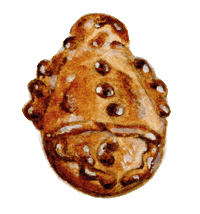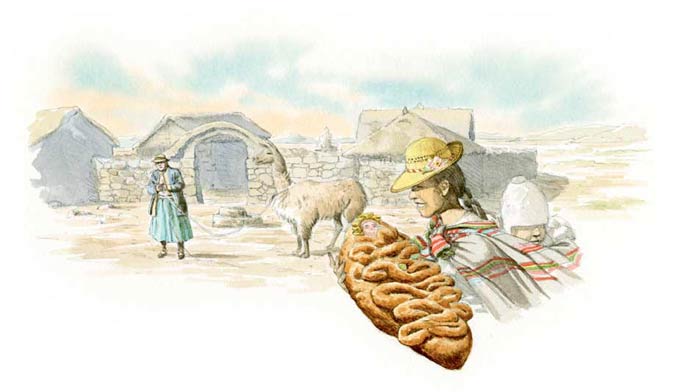T’anta wawa

Form: Bread doll
Country of origin: Peru
What distinguishes it from other methods of bread making: Sugary bread, or almost cake, flavored with chamomile, fennel and anise
Category of bread: (10) hese bread dolls are found in different services for the saints and the dead, in Latin America (bread of the dead and pan de los muertos) as well as in Europe (lazaroudia in Greece, colaci in Rumania).
Particularity: Shaped like animals or human beings of all ages
Ingredients: Wheat flour; baker’s yeast; sugar; cinnamon; sesame seeds; eggs; butter; milk; vanilla; water

Peru
Like all bread dolls offered to the dead, t’anta wawas illustrate that the dead are not really dead. Even though they are dead, one has to continue feeding them. This is done on very special occasions, such as All Saints’ Day, the Day of the Dead, St. Nicholas, Christmas, Holy Week, Carnival, etc. During religious or lay rituals, the living come to pay a sort of tribute to those who have been separated from the community. These practices take on different forms in different cultures. Were the Egyptians the first to initiate them? Archeologists have excavated tombs on the western banks of the Nile where they found bread that accompanied the dead in their eternal voyage.
These breads can be savory or sweet, and they sometimes verge on being cakes. Symbolically, they take on the traits of the deceased whose memory is being honored. It can be bread dolls, calling to mind an adult, child, or even newborn who has died, or it can be an animal, such as a llama, horse, bull, dove, etc. The bread figurine is then put on the alter, arranged for the occasion on the tomb of the deceased. The living gather together and make lively gestures to the one who has left this world. The bread nourishes the ritual. At the same time, it sends a message from the living to the dead, and makes the dead reappear in the form of this elongated doll dressed for the occasion with flowers and candles.
Traditionally, it was women who were in charge of making these bread dolls, but now bakers have taken over. Bakers even participate in the national competition for t’anta wawas organized by the National Peruvian Culture museum (the first competition took place in 1996).

